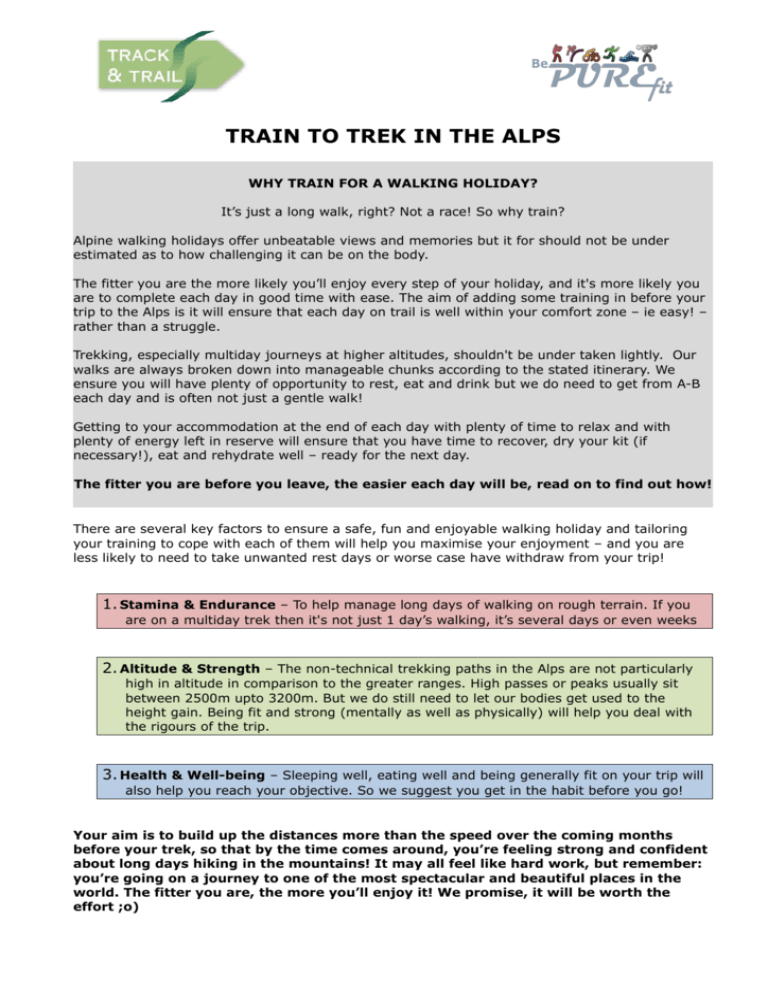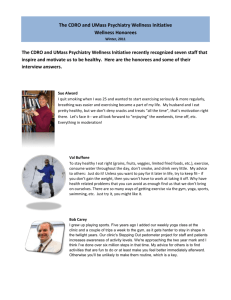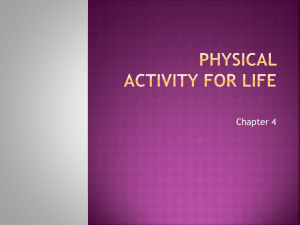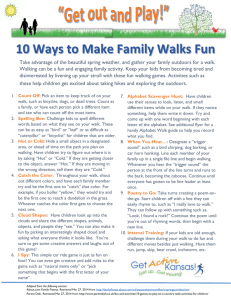Train to Trek in the Alps
advertisement

TRAIN TO TREK IN THE ALPS WHY TRAIN FOR A WALKING HOLIDAY? It’s just a long walk, right? Not a race! So why train? Alpine walking holidays offer unbeatable views and memories but it for should not be under estimated as to how challenging it can be on the body. The fitter you are the more likely you’ll enjoy every step of your holiday, and it's more likely you are to complete each day in good time with ease. The aim of adding some training in before your trip to the Alps is it will ensure that each day on trail is well within your comfort zone – ie easy! – rather than a struggle. Trekking, especially multiday journeys at higher altitudes, shouldn't be under taken lightly. Our walks are always broken down into manageable chunks according to the stated itinerary. We ensure you will have plenty of opportunity to rest, eat and drink but we do need to get from A-B each day and is often not just a gentle walk! Getting to your accommodation at the end of each day with plenty of time to relax and with plenty of energy left in reserve will ensure that you have time to recover, dry your kit (if necessary!), eat and rehydrate well – ready for the next day. The fitter you are before you leave, the easier each day will be, read on to find out how! There are several key factors to ensure a safe, fun and enjoyable walking holiday and tailoring your training to cope with each of them will help you maximise your enjoyment – and you are less likely to need to take unwanted rest days or worse case have withdraw from your trip! 1. Stamina & Endurance – To help manage long days of walking on rough terrain. If you are on a multiday trek then it's not just 1 day’s walking, it’s several days or even weeks 2. Altitude & Strength – The non-technical trekking paths in the Alps are not particularly high in altitude in comparison to the greater ranges. High passes or peaks usually sit between 2500m upto 3200m. But we do still need to let our bodies get used to the height gain. Being fit and strong (mentally as well as physically) will help you deal with the rigours of the trip. 3. Health & Well-being – Sleeping well, eating well and being generally fit on your trip will also help you reach your objective. So we suggest you get in the habit before you go! Your aim is to build up the distances more than the speed over the coming months before your trek, so that by the time comes around, you’re feeling strong and confident about long days hiking in the mountains! It may all feel like hard work, but remember: you’re going on a journey to one of the most spectacular and beautiful places in the world. The fitter you are, the more you’ll enjoy it! We promise, it will be worth the effort ;o) STAMINA & ENDURANCE: GET UP INTO THE HILLS: The ideal training for walking is walking! IE: so as much as possible to mimic the exercise you’ll be doing on the trek as much as possible. This means: long days hill walking with a rucksack (5-6 hours), taking in some steep terrain - both up and down - and ideally incorporating overnight stays and back to back days. Most people find going uphill harder on the lungs and going downhill harder on the body (knees in particular). You may need to build up to it before you’re comfortable with back to back days walking, so we’d recommend getting out to the hills for weekend walks well in advance of the trip. If you do find your body hurts (esp from walking downhill), don’t give up! Rest, and when you’ve stopped aching, go back for more – you’ll find it gets easier and easier as your joints get used to it. Speed: It’s important to find a pace you’re comfortable with and can maintain for several hours. Don’t worry about being slow and holding people up – on the actual trip, you’ll have the opportunity to walk at your own pace, so concentrate on finding ‘your’ speed and being able to stick to it. Distance and route planning: If you’re not sure how fast you walk, you can use a treadmill to work out a flat speed and a hill speed that suits you. This will help you with route planning and distances. Walk in pairs/groups, let someone know where you’re going, make sure you have maps, suitable equipment/clothing etc etc ... GET ‘DOWN THE GYM’ (or outside!): Time is often the limiting factor for busy people. Focussed gym based training will make a huge difference to how well you cope with long days in the hills. What type of exercise? We’d recommend running/jogging or cycling – either indoor or outdoor, or a mixture. Walking is also a good form of training and should be an important part of everyone’s preparation. If you choose to focus on walking as your main form of exercise, you will need to be doing longer sessions then the equivalent run or bike ride. However, if running or cycling really aren’t your thing, there are plenty of alternatives to build your endurance fitness. You could consider swimming (great for taking the pressure off your joints), or competitive sports such as tennis/squash. The aim is to raise your heart rate and get you sweating! We’d also recommend incorporating stretching and strength training to help balance your body, prevent injuries, and cope with the increased demands of training more, and carrying a pack while walking. Gym vs Outdoors? The gym is great for ease and accessibility, for working out under supervision, and for keeping track of your progress. Exercising outdoors on the other hand may be more relaxing, more realistic, and more fun! If you want to measure your outdoor workouts in the same way as in the gym, think about investing in a specialist watch and heart rate monitor which will measure your speed, distance, heart rate, calories burnt etc. For outdoor workouts, have a look online for running/walking routes or cycling routes in your area. Try www.run.com or www.cycle-route.com for ideas. Aim to include 1 of each of the following per week: Please note: The examples are examples only – everyone’s time and speed will vary, so adjust accordingly for your own pace. Don’t worry about what anyone else is doing or how fast they go. On the trip you’ll be able to go at your own pace - it’s a journey, not a race! Progressing with your training will require challenging yourself, but push yourself within your own limits - not so hard you get injured. If at any point during your training you suffer unusual pains/dizziness/shortness of breath, consult a doctor before carrying on with your training. If you’re not sure where or how to start, your local gym will be able to put you in touch with a coach or personal trainer who can devise a training programme specifically for you. DON’T FORGET TO WARM UP AND WARM DOWN BEFORE AND AFTER EACH SESSION. YOUR WARM UP SHOULD INCLUDE STRETCHES AND A GENTLE BUILD UP TO YOUR MAXIMUM EFFORT. YOU CHOOSE WHICH STYLE OF AEROBIC WORK OUT YOU'D PREFER SUCH AS RUNNING, CYCLING, WALKING. 1. Med distance cardio session. This is probably your ‘normal’ workout - your default run or bike ride, at a steady pace that has you breathing quite hard and sweating a bit - but you feel like you have something in reserve. You should be able to have a short conversation while you’re exercising. Example med distance session: 40 minute run or 1 hour minute bike or 1h30 walk 2. Short sprint cardio session. This is a shorter session, where you’ll be working hard, quite out of breath and sweating. You may be working up to 30% harder than your normal med distance pace - but for a shorter time. This session is designed to improve your overall fitness. The aim of this workout is to work your lungs and legs harder than normal, ‘raising the bar’ to build up your emergency reserves and overall fitness level. You can fit a sprint session into less than half an hour, so it’s a great work out if you’re in a rush. Please note: The aim of this session is to push yourself, but you may need to build up to it – listen to your body and don’t work too hard, at least initially, until you know your own limits. You may be at a higher risk of injury during this session as you’ll be exercising out of your comfort zone, so if you’re not very fit when you start, build up slowly! You may want to introduce ‘intervals’ to help you progress – eg 5 minutes warm up at your normal pace, then 2 minutes sprint, 1 minute recovery, 3 minutes sprint, 1 minute recovery, 4 minutes sprint, 1 minute recovery, 5 minutes sprint, 3 minutes recovery. Example short distance session: 10 min warm up 25 minutes interval session as above and 10 minute cool down 3. Long distance cardio session. This is an endurance session. In this workout, you’ll drop your normal pace, but exercise for longer. You should find the speed easy at the beginning of the work out, and you’ll feel like you’re holding back. But by the end you should feel tired. If you do a long weekend hill walk, that will count instead of this long gym session. Please note: You may find a long session hard to fit in and/or boring, but is vital in the long run so stick with it! Taking the session outside and varying between running, hill walking and cycling will help keep you interested. Going with friends may also help keep you motivated. Example long distance session: 1 hour (or more if you can!), 1h30 by bike, 3 hour walk 4. Strength & Stretching session. Think of your body as a solid core (your trunk) with loose, rotating limbs (your arms and legs) attached. When you run / walk / cycle, it’s not your legs powering you through, it’s your stable core that drives the loose rotating limbs to get you there! Think about having a strong body and light limbs. Being strong in your core and flexible in your body will make a massive difference to how you feel on a multi day trek, as well as helping prevent injuries. Yoga, pilates, stretching, and abs work are all good options. Carrying a rucksack will automatically alter your posture and put new strains on your joints. The stronger your core muscles (all the ‘interior’ muscles from your ribs to your hips), the better prepared you’ll be to support extra weight for many days. Example Strength / Stretch session. 1.5 hours yoga / pilates session or 1 hour stretching and ½ hour abs session Health and Well Being: For busy, hard working people, fitting regular exercise into the diary can be difficult, so here are some top tips for general health and well being - including some ideas to help you lose weight if you think that will help you reach your goal. 1. Rest & Sleep. We advise taking 2 full days off per week to chill out. DO NO EXERCISE!! This is when your body recovers and you’ll feel better for it. Your body recovers fastest, mends damage, and builds muscle best when you are asleep. Getting ‘fitter’ actually happens when you’re doing nothing, so resting well is as important as exercising well. Try to get at least 7 hours sleep a night. 2. Injury. If you start to feel a niggle developing, act on it! We recommend consulting a doctor or sports physiotherapist as soon as you develop an injury – however mild – as they will be able to give you specific exercises or treatments to help straight away and prevent it worsening. Don’t let niggles turn into full blown injuries! Everyone has biomechanical imbalances in their body that have developed over many years: ‘weak’ spots, which may be at risk of injury when you increase your exercise level. If you do develop minor injuries during your training, a sports therapist or physio will be able to suggest strength exercises or stretches specifically for you that will prevent further damage and help you improve your overall fitness. 3. Keeping motivated. If you have a bad work out, don’t worry about it! If you have 5 bad work outs in close succession, you need to think about why: are you Tired? Bored? Injured? Stressed? Unmotivated? Expecting too much? Tired? Really tired or just sluggish/bored? If you’re really tired, and think you’ve been over-doing it, then take time off; whether it’s 1 day or a whole week. Listen to your body – but be honest with yourself! Bored? Change what you’re doing. Get outside, run with a friend, bike instead of run, plan a trip to somewhere beautiful for a walk, join a club. Create a new challenge for your workout – a new time goal, route, distance, enter a local race so you have something to train for. Injured? See a doctor / physio! Stressed? Exercise is ultimately relaxing – when you exercise you stimulate ‘feel good’ hormones called endorphins. You can’t help but feel better afterwards! Unmotivated? Take the pressure off! Instead of promising yourself you’ll run for an hour after work, but really dreading it all day, say to yourself you’re going to run for 10 minutes - and if you feel like it, you’ll carry on for longer. If after 10 minutes you’ve really had enough, stop. Use the time you’d allocated for exercising to do something else you enjoy. If after 10 minutes you find you actually feel quite good, then carry on. More often than not, you’ll complete a full work out. Often, the thought of doing something can be far worse than actually getting on and doing it - it’s a cliché, but big tasks broken down into small chunks are much more manageable. Expecting too much? Don’t beat yourself up if you don’t see progress for a while, it’s likely to go in stages. If you’re repeating exactly the same exercise routine week in week out, think about variety. Vary your speed, inclination, location, change the type of exercise you’re doing. Your body needs different stimulation as well as your brain. Try a different class at the gym, go walking in a new area, meet up with a different running partner... 4. Nutrition and weight loss – If you’d like to lose weight prior to your trip, here are a few ideas: Breakfast like a king, lunch like a prince, dinner like a pauper. An ‘old-school’ expression, maybe, but it works. If you eat a large breakfast, it’ll keep you going all day and you’ll burn all the calories off during the day. If you eat a large meal at night, you go to bed with a full stomach, and the calories you’ve consumed are ‘unused’ and stored. The simple equation is if you burn off more calories than you consume, you’ll lose weight! Carbohydrates – the current trend is that all carbs are evil. Not so, but choose wisely and limit your portions if you want to lose weight. Aim for brown instead of white (bread, rice, pasta). Go for a wrap instead of a sandwich/roll. Fill up on lean protein and salad/vegetables. Try to eat fewer or no carbs in the evening. Exercise supplements and drinks – unless you’re exercising for more than 1.5 hours, you’re unlikely to need any kind of ‘sports drink’ or bars. They are effective at replacing lost sugars and salts fast, but are high in calories. You should get all the energy, minerals, salts and sugars you need from a balanced diet. If you’re going for a long run/bike ride/hike (1.5 hours+), sports drinks, bars, gels etc can be very useful – they fit in your pocket and give you a vital boost of balanced sugars and salts when you start to run out of steam on a long run/ride. Most people can’t sustain high levels of exercise for more than 1-1.5 hours without some water and nutrition. Water – always keep hydrated! Concentrate on staying hydrated all the time by sipping drinks throughout the day, and ideally while you’re exercising too. Aim to drink at least 2 litres of water a day (in addition to other drinks), and make sure you drink lots of water after exercise. If you feel thirsty, you’re actually already dehydrated! Protein after exercise – studies have shown that eating protein within half an hour after exercise can help build / repair muscles. This can be in the form of protein shakes or bars, but it doesn’t need to be! Nuts or seeds, lean meat, eggs, cheese, beans and soya are all good sources of protein. Exercise on an empty stomach – the best time to exercise for weight loss is first thing in the morning, before breakfast. You’ll immediately start using up stored energy supplies (fat!) rather than burning up the food that’s already in your system. You’ll also kick start your metabolism early, which means you burn calories at a faster rate all day. If you struggle with getting going first thing, have half a banana before you exercise. If you don’t exercise in the morning, try to leave 2 hours after your last food before you exercise. Try to avoid exercising late at night – the endorphins buzzing around your system may mean you have trouble sleeping. Exercising more? Need more food? –If you’re exercising more than normal, you may need to eat more to keep your energy levels up. Unfortunately for food lovers, it’s likely that you don’t need as much extra food as you think – especially if you are trying to lose weight! If you keep track on a gym machine or heart rate monitor, it can be dispiriting to see how few calories you’re actually burning. Try not to fall into the habit of ‘treating yourself’ after a workout: 40 minutes on the running machine is more likely to ‘equal’ a banana than a burger and chips!! However, as your body changes with exercise, your lean muscle mass and overall metabolic rate will both increase, meaning you burn calories faster and you may find yourself in need of more food. Listen to your body and if you’re hungry try to choose healthy meals and snacks throughout the day to keep you going. Try not to let yourself get too hungry or you’ll risk overeating, and try to eat slowly so your brain has time to register when you’re full – it apparently takes 20 minutes for your stomach to ‘tell’ your brain it’s had enough! WE HOPE THIS HELPS GIVE YOU SOME IDEAS ... REMEMBER TO ENJOY YOUR TRAINING! This article was written by Steph Willet. Steph owns Be Pure Fit and is a yoga teacher, sports therapist and personal trainer - with a diploma in nutrition. Steph works with Tracks and Trails on our Detox and Wellness weeks aswell as out Trail Running Camps. She is seriously fit and healthy and is fascinated by the human body and the relationships between exercise, food and health. Whether it's raw juices or healthy salads, Steph loves the amazing energy you can only get from eating, sleeping and exercising well. If you have any questions about fitness training, nutrition and diet prior to your trip to the alps then please feel free to get in touch with Steph : info@tracks-and-trails.com







